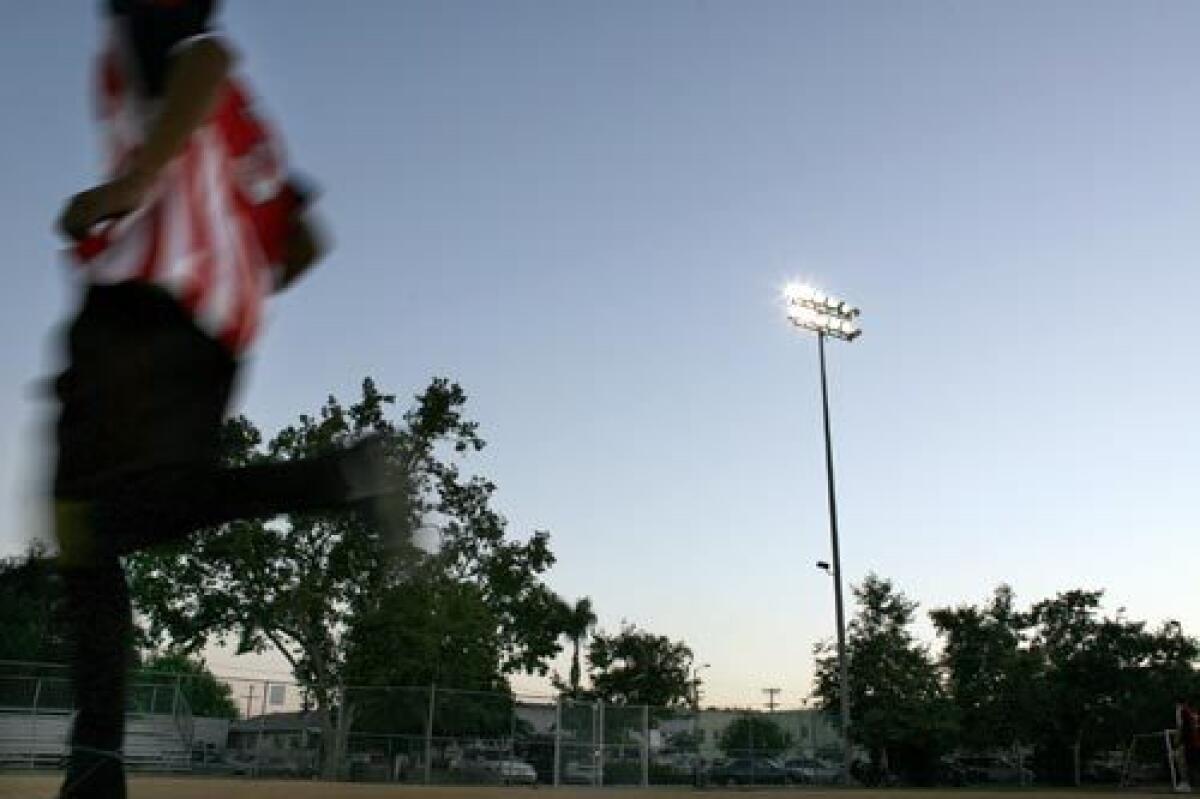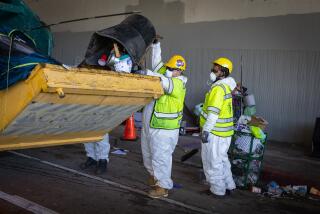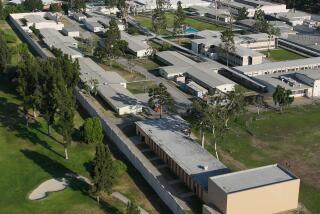Program offers rays of hope in an area on the edge

>>more photos >>
Words failed Roslyn Haywood-Broadnax, and that doesn’t happen often. Her eyes softened and she pointed to the ceiling -- or, rather, through it, toward the heavens.
Her three oldest are grown and gone, one a mental health counselor, one a hospital administrator, one studying crime-scene investigation. Her youngest, Arah, is on her way to Howard University to study psychiatry.
No drugs, no gangs, no arrests. She’s not sure how she pulled it off, raising four children here, in the heart of South Los Angeles. Mostly, she said, she just prayed -- that they would make it to school safely, learn something while they were there, make it home at the end of the day.
Haywood-Broadnax, 47, couldn’t chat long; she was on her way to join neighbors on a picket line outside the headquarters of the L.A. Unified School District, which recently cut most summer school programs to save money. That decision, shrugged off in some areas as an inconvenience, is viewed by many in South L.A. as a betrayal.
“It angers me in my soul,” Haywood-Broadnax said. “People here don’t have money for camp. Parents can’t afford to take time off from work. Shutting down schools means pushing kids into the street. It’s going to be a mess.”
Enter Summer Night Lights, a recreation program that may never have been more needed.
For weeks, City Hall has been ramping up for its newly expanded summer parks program, in which the lights will be kept on until midnight Wednesdays through Saturdays at 16 recreation areas, most of them in crime-ridden communities.
Summer Night Lights was already widely anticipated in South L.A., which is home to five of the 16 sites and abuts three others. Now, the program, which begins Wednesday and runs through Sept. 5, is seen as essential; it represents the sum of the distractions available to thousands of children and teenagers.
“There is so much riding on this,” said Danielle Lafayette, a City Hall gang reduction manager who is overseeing Summer Night Lights programming at Mount Carmel Recreation Center. Six gangs claim territory within three blocks of the park, which is west of the Harbor Freeway and north of Florence Avenue.
The summer school decision could not have come at a more critical time for South L.A.
There are suggestions that the area, long plagued by so much violence that city officials a few years back did away with the name “South-Central” in an attempt to shed its stigma, is at a tipping point.
Social services are flooding in, tens of millions of dollars in construction projects are underway and the city won court approval earlier this year to roll out an injunction targeting gangs in a 13.7-square-mile patch of South L.A., the largest such police action in state history. The injunction restricts the movements and activities of six gangs that together claim at least 3,000 members.
The city’s cautious optimism is based largely on falling crime rates, especially gang violence. In the LAPD’s Newton and 77th Street divisions, the two responsible for enforcing the injunction, there had been 24 homicides by June 27, compared with 52 for the same period two years ago. That’s a 54% drop.
Some who work the streets say the tenor of the neighborhood is changing in subtle ways. In the past, certain shootings -- those that took place on a particularly contested block, for instance -- almost always unleashed a wave of violence.
“That’s just not happening right now,” said Jorge Reyes, a regional supervisor in the mayor’s Office of Gang Reduction & Youth Development, known as GRYD.
But summer, historically, is the most violent time of year here, and a bad one could undo much of the progress, authorities say.
That concern dominated a recent meeting between Newton commanders and school officials, even amid reports of gang recruitment and rampant marijuana use among students. Some area schools have year-round schedules and are not affected by the summer school cuts; others, like Jefferson High School, have traditional schedules, and are.
“What happens with those schools?” asked Capt. Mark Olvera, Newton’s commander.
“Officially, the doors are closed,” outgoing Jefferson Principal Juan Flecha responded.
“We’re very concerned about that,” Olvera told him.
“It’s going to leave a big hole,” added L.A. School Police Sgt. Lyndon L. Cullen.
The increased pressure on Summer Night Lights to help deliver a relatively peaceful season has created a feverish atmosphere around preparations.
The program began last year at eight parks. Law enforcement officials were wary of keeping the facilities open so late, especially in areas where parks have been used in recent years as gathering spots for gangs.
“These are places where people would not go during the day,” much less at night, said Summer Night Lights director Guillermo Cespedes.
But the results, Mayor Antonio Villaraigosa said Monday in a speech, were unmistakable. In the neighborhoods surrounding those parks, the number of shooting victims fell by 43% and gang homicides by 86%.
“This summer we’re going to double down,” he said.
The city added eight more sites. Each will be staffed by supervisors and a 10-member “youth squad” -- at-risk teenagers who live nearby and have been identified as potentially either perpetrators or victims of violence.
Free meals will be served most nights; the city is prepared to serve 350,000 dinners this summer. The parks will offer “youth-centered” recreational activities, including sports leagues, skate parks and arts and crafts. Families are welcome.
So are gang members; in most cases, the city has agreed to suspend injunctions barring two or more gang members from appearing together in public if they do not cause trouble and are attending one of the park programs.
“You involve people who are part of the problem to become part of the solution,” Cespedes said. “Our basic goal is to just lower the temperature of the city.”
In South L.A., that can be complex.
This week, members of the “youth squads” were assigned to canvass their neighborhoods to raise awareness about the program. At Mount Carmel Park, an intervention worker announced they’d be fanning out across an area south of the park, near Figueroa Street.
“I don’t know if I can go down there,” said one member, Tyrone Washington, 18. He explained that he grew up a few blocks north of the park, in the territory of the Menlo Gangsters. To the south, Florence Avenue is the dividing line between Menlo and a traditional rival, the 74 Hoovers.
“I don’t bang,” Washington said, meaning he was not a gang member. But if he went into the wrong neighborhood, he said, there could be a perception that he was affiliated with Menlo simply because of where he grew up. His “youth squad” T-shirt, he said, would offer him no protection.
“Well, they could get us out there or they could get us in here,” said Robert Rubin, the intervention worker, a former Westside Crip who went on to a career in economic development. “We’ve got to start somewhere. I will put my life in front of yours.”
So, with intervention workers flanking them for protection, the youth squad stepped gingerly into Hoover territory.
Before long, a Hoover gang member pulled up next to the group in his car, shouting: “Meatloaf!” Most gangs have derogatory names for their rivals; “meatloaf” is what rivals call the Menlo Gangsters. An intervention worker quickly explained what the group was up to, and it was granted safe passage.
After two days of canvassing, Washington had distributed fliers throughout Hoover territory and had collected four pages’ worth of contact information from parents interested in the parks program.
“If we don’t make it work, there’s going to be trouble,” Washington said, walking back to Mount Carmel.
Back at her little house off Gage Avenue, Haywood-Broadnax -- a founding member of a parent organization called Community Asset Development Redefining Education, or CADRE -- said she still wasn’t convinced the program could compensate for the loss of summer school, but she was hopeful.
“People who make the decisions just don’t think about the side effects,” she said. “Here’s what I do know: It’s going to be an interesting summer around here.”
More to Read
Start your day right
Sign up for Essential California for news, features and recommendations from the L.A. Times and beyond in your inbox six days a week.
You may occasionally receive promotional content from the Los Angeles Times.







